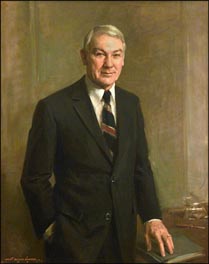G. William Miller
George William Miller (March 9, 1925 in Sapulpa , Oklahoma , † March 17, 2006 in Washington, DC ) was an American politician , Treasury Secretary and President of the Federal Reserve System .
Studies and professional career
Studied and worked as a lawyer
After attending school, he completed a degree in marine engineering from 1942 to 1945 at the United States Coast Guard Academy (USCGA), from which he graduated in 1945 with a Bachelor of Science in Marine Engineering (B.Sc. ME) . He then served for four years as a Coast Guard officer in the Far East and the West Coast of the United States . He then completed a law degree at the University of California at Berkeley (California) , from which he graduated in 1952 with a Bachelor of Laws (LL.B.). He then joined the law firm Cravath, Swaine & Moore in New York City, founded in 1819, as an attorney.
Rise to Textron Chairman and serve under President Lyndon B. Johnson
In 1956 Miller joined the US conglomerate Textron . As early as 1957 he became vice president and in 1960 after the departure of the company founder he became its president. In 1968 he was first Chief Executive Officer (CEO) and then in 1974 also Chairman of Textron.
In the meantime, from 1963 to 1965, he was also chairman of an industrial advisory body on a committee under President Lyndon B. Johnson , which dealt with equal opportunities in the labor market . Under Johnson, he was also a member of the National Council for the Humanities from 1966 to 1967 . After all, he was also a member of the Club of Rome .
Political career
Chairman of the Federal Reserve System
On March 8, 1978, he became chairman of the Federal Reserve System , the United States' central banking system (Fed). When he took over from his predecessor Arthur F. Burns , the US economy was in a dire situation with high inflation . However, the measures he initiated against this did not show any apparent success. On July 17, 1978, a cartoon of him titled "Inflation Fighter" was on the cover of TIME magazine .
Treasury Secretary under President Carter and Chrysler Rescue
On August 6, 1979, he was appointed Secretary of the Treasury of the United States by President Jimmy Carter as part of a cabinet reshuffle to succeed W. Michael Blumenthal . This cabinet reshuffle, however, was spurred by Miller's ambitions for Blumenthal's office. He was succeeded as President of the Federal Reserve System by Paul Volcker .
During his tenure, the automobile company Chrysler was facing bankruptcy in 1979. Miller introduced a bill (Chrysler Corporation Loan Guarantee Act of 1979) into the US Congress , which provided for extensive state guarantees (state wage guarantee in the amount of 1.5 billion US- $) and Chrysler under the then new CEO Lee Iacocca before Bankruptcy saved.
Miller, he was the only politician who was both Fed President and Treasury Secretary. Even though Miller was a gifted business executive, his economic policies to fight inflation and lower the unemployment rate failed. Ultimately, the weak economic situation in particular was the main reason for President Carter's defeat in the 1981 election by Ronald Reagan .
Donald Regan succeeded him as Treasury Secretary of the new Reagan administration .
Offices and awards in the last years of life
After his retirement from politics, Miller was not only chairman of the G. Miller Merchant Bank Inc. in Connecticut , which he founded , but also treasurer of the American Red Cross (ARC) , vice president of the National Academy of Sciences (NAS) from 1983 to 1987 from 1989 to 1992 and from 2000 to 2005 chairman of the H. John Heinz III Center for Science, Economics and Environment.
Miller have received several honorary academic degrees. He was also a visiting scholar at the University of California and, in 1984, he held the Lloyd Bentsen Professorship in State and Business Relations at the Lyndon B. Johnson School of Public Administration at Texas State University-San Marcos .
Web links
- Biography and portrait on the US Treasury Department homepage
- Biography in rulers.org
- G. William Miller in Miller Center of Public Affairs of the University of Virginia (English)
- Obituary on the US Coast Guard homepage
- Obituary in The Boston Globe on March 19, 2006
- Obituary in The Washington Post, March 20, 2006
Individual evidence
- ^ G. William Miller. In: time online. July 17, 1978. Retrieved July 6, 2018 .
| personal data | |
|---|---|
| SURNAME | Miller, G. William |
| ALTERNATIVE NAMES | Miller, George William |
| BRIEF DESCRIPTION | American politician, Treasury Secretary and President of the US Federal Reserve |
| DATE OF BIRTH | March 9, 1925 |
| PLACE OF BIRTH | Sapulpa , Oklahoma |
| DATE OF DEATH | March 17, 2006 |
| Place of death | Washington, DC |



